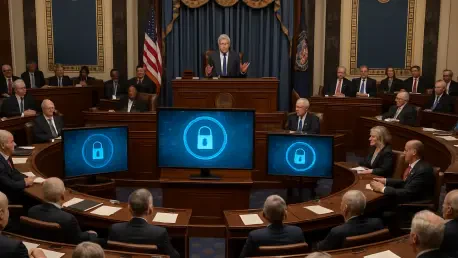In an era where digital threats loom larger than ever, with cyberattacks targeting everything from critical infrastructure to personal data, a pressing question emerges: can legislative action provide the necessary shield against these invisible assaults, and will it be enough to protect the nation? The U.S. Senate is stepping into the fray with a bipartisan effort to reinstate and enhance expired cybersecurity measures, aiming to fortify national defenses against an increasingly sophisticated array of cyber threats. At the heart of this movement is the Protecting America from Cyber Threats Act, a bill designed to renew vital mechanisms for sharing cyber threat information between private entities and government agencies. This initiative, alongside other complementary legislation, reflects a growing recognition of cybersecurity as a cornerstone of national security. As malicious actors evolve their tactics, the urgency to rebuild and innovate defensive strategies has never been clearer, setting the stage for a critical examination of whether these Senate efforts can truly safeguard the nation’s digital landscape.
Strengthening Public-Private Collaboration
The cornerstone of recent Senate efforts lies in reviving expired frameworks that foster collaboration between private companies and federal agencies, a partnership deemed essential for combating cyber threats. The Protecting America from Cyber Threats Act, introduced by Senators Gary Peters and Mike Rounds, seeks to renew the Cybersecurity Information Sharing Act, which lapsed recently. This legislation encourages voluntary sharing of critical cyber threat indicators, such as malware signatures and malicious IP addresses, with the Department of Homeland Security. By reinstating liability protections for participating companies and embedding strong privacy safeguards, the bill aims to prevent data breaches and enhance responses to major cyberattacks like SolarWinds. Supported by prominent industry groups, this measure underscores a shared understanding that public-private synergy is vital for bolstering national cyber resilience in an era of relentless digital assaults.
Beyond the immediate revival of information-sharing mechanisms, the broader implications of this legislative push reveal a strategic effort to rebuild trust and efficiency in cybersecurity practices. The renewed framework not only addresses past vulnerabilities exploited in significant breaches but also sets a precedent for proactive defense against emerging threats. By creating a secure channel for data exchange, the bill ensures that both government and industry can respond swiftly to incidents, minimizing damage and disruption. Moreover, the bipartisan support for this initiative signals a rare unity in addressing a non-partisan issue, highlighting the universal stakes involved. As cyber adversaries continue to exploit gaps in coordination, this renewed emphasis on collaboration could serve as a linchpin for a more resilient digital ecosystem, provided implementation matches the ambitious intent behind the legislation.
Preparing for Future Cyber Challenges
In addition to addressing immediate cybersecurity needs, Senate lawmakers are casting their gaze toward horizon threats, particularly those posed by technological advancements like quantum computing. The National Quantum Cybersecurity Migration Strategy Act, introduced by Senators Peters and Marsha Blackburn, represents a forward-thinking approach to prepare federal systems for the potential disruptions quantum technology could unleash. This bill aims to develop a comprehensive strategy to mitigate risks associated with quantum advancements that could render current encryption obsolete. By prioritizing readiness for such paradigm-shifting innovations, the legislation acknowledges that cybersecurity is not just about reacting to today’s threats but anticipating tomorrow’s challenges, ensuring that national defenses evolve in tandem with technological progress.
Complementing this focus on future risks, another bipartisan effort, the Streamlining Federal Cybersecurity Regulations Act, proposed by Senators Peters and James Lankford, seeks to harmonize the patchwork of cybersecurity rules across federal agencies. This initiative aims to establish a unified regulatory framework through an interagency committee, reducing compliance burdens and enhancing efficiency. Such harmonization is crucial as inconsistent regulations often create loopholes that cyber attackers exploit. By fostering a cohesive policy environment, this bill could eliminate redundancies and strengthen overall security posture. As digital threats grow more complex, these legislative measures collectively signal an understanding that preparing for the future requires both innovation in strategy and consistency in execution, positioning the nation to stay ahead of adversaries in an ever-changing cyber landscape.
Innovating National Security Approaches
Beyond traditional legislative fixes, there is a noticeable shift toward integrating innovative models inspired by private sector agility into national security strategies. The U.S. Army, for instance, is adopting a Silicon Valley-inspired approach to accelerate the development and deployment of critical technologies and weapons systems. By identifying and funding promising startups to deliver minimally viable products quickly, this model prioritizes speed and adaptability over bureaucratic delays. This trend reflects a broader recognition that government operations must embrace modern methodologies to keep pace with rapidly evolving threats. Such innovation in implementation could redefine how cybersecurity tools and defenses are developed, ensuring they are both cutting-edge and readily available to protect national interests.
Parallel to military innovation, other federal initiatives are exploring scalable solutions in critical sectors like health, which often intersect with cybersecurity concerns. The Advanced Research Projects Agency for Health is actively seeking proposals to advance resilient systems and health innovations, aligning with the overarching goal of safeguarding vital infrastructure. This cross-sector approach highlights the interconnected nature of modern security challenges, where a breach in one domain can ripple across others. Additionally, leadership transitions, such as the advancement of Kirsten Davies’ nomination for the Department of Defense’s Chief Information Officer role, bring seasoned industry expertise into federal strategy. These combined efforts illustrate a dynamic push to modernize national security, leveraging both technological and human capital to build a more robust defense against cyber threats.
Reflecting on a Unified Cybersecurity Path
Looking back, the bipartisan efforts in the Senate demonstrated a rare alignment on the critical importance of cybersecurity, uniting lawmakers, military leaders, and federal agencies in a shared mission to counter sophisticated digital threats. The Protecting America from Cyber Threats Act, alongside complementary bills, tackled immediate vulnerabilities while laying groundwork for future resilience. Initiatives like the Army’s adoption of private sector models and strategic nominations underscored a commitment to innovation and expertise. Moving forward, the focus should remain on seamless implementation of these policies, ensuring that collaboration between public and private entities translates into tangible protections. Stakeholders must also prioritize continuous adaptation to emerging threats, investing in research and training to maintain a proactive stance. These steps, built on the foundation of past legislative resolve, offer a pathway to not just revive but revolutionize national cybersecurity defenses for the challenges ahead.









